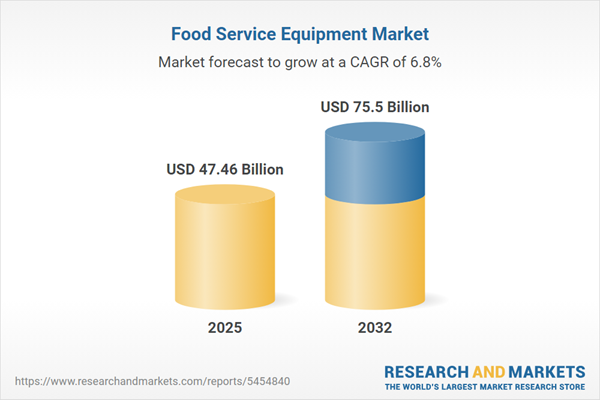Speak directly to the analyst to clarify any post sales queries you may have.
The food service equipment market is undergoing rapid transformation as industry leaders respond to shifting operational demands, regulatory requirements, and major advances in connected and sustainable technologies. Senior executives can expect significant changes in procurement strategies, customer expectations, and the overall competitive landscape.
Market Snapshot: Food Service Equipment Market Growth and Opportunities
The global food service equipment market expanded from USD 44.43 billion in 2024 to USD 47.46 billion in 2025 and is on track for further growth, projecting a CAGR of 6.84% to reach USD 75.50 billion by 2032.
This market outlook reflects robust demand across North America, Latin America, Europe, Middle East & Africa, and Asia-Pacific, driven by evolving operational models, increased adoption of advanced automation, and a heightened focus on sustainability.Scope & Segmentation of the Food Service Equipment Market
- Product Types: Beverage equipment (blenders, coffee machines, dispensing equipment, ice makers), cooking equipment (fryers, griddles & grills, ranges & ovens, steamers), holding & warming equipment (food warmers, heat lamps, proofing cabinets), refrigeration solutions (condensing units, freezers, reach-in and walk-in refrigerators), ventilation (exhaust fans, filters, hoods), and warewashing appliances (dishwashers, glasswashers, pot washers).
- End Users: Cafes & bars (including coffee shops, bars, and pubs), full service restaurants (casual and fine dining), hotels & hospitality (hotels, resorts, cruise ships), institutional & healthcare (schools, universities, government institutions, hospitals), and quick service restaurants (pizza delivery, burger chains, sandwich shops).
- Distribution Channels: Direct sales, distributors & dealers, online channels.
- Geographic Regions: Americas (United States, Canada, Mexico, Brazil, Argentina, Chile, Colombia, Peru), Europe, Middle East & Africa (United Kingdom, Germany, France, Russia, Italy, Spain, Netherlands, Sweden, Poland, Switzerland, United Arab Emirates, Saudi Arabia, Qatar, Turkey, Israel, South Africa, Nigeria, Egypt, Kenya), and Asia-Pacific (China, India, Japan, Australia, South Korea, Indonesia, Thailand, Malaysia, Singapore, Taiwan).
- Technology Adoption: Advanced automation, Internet of Things connectivity, energy-efficient controls, low-global-warming-potential refrigerants, digital interfaces, and predictive maintenance systems.
Key Takeaways for Senior Decision-Makers
- Heightened consumer expectations and labor constraints are accelerating the adoption of versatile, automated equipment platforms that optimize operational workflows and reduce manual intervention.
- Eco-friendly design is moving from compliance to a strategic imperative, with both manufacturers and operators prioritizing energy efficiency and sustainable refrigerants for improved cost control and corporate responsibility.
- The rise of digital connectivity enables real-time equipment monitoring, proactive maintenance protocols, and integration with front-of-house and delivery solutions, reducing downtime and enhancing performance transparency.
- Flexible, modular equipment portfolios are increasingly favored to accommodate agile transitions between dine-in, takeout, and delivery models, supporting resilience amid rapid market changes.
- Shifting procurement strategies and industry partnerships, including collaboration on localized manufacturing and distribution, are critical to managing supply chain disruptions and total cost of ownership.
Impact of 2025 Tariffs on Market Operations and Sourcing
- Recently introduced U.S. tariffs have prompted both manufacturers and buyers to reassess import strategies, with many opting for domestic component sourcing and modular equipment that provides agility in navigating policy shifts.
- Strategic partnerships, particularly involving original equipment manufacturers and local suppliers, are emerging as a key tactic to absorb tariff costs and maintain pricing competitiveness.
- Downstream impacts are inspiring design innovations that lower reliance on imported parts and enable longer equipment life cycles, supporting predictable maintenance and service costs for operators.
Methodology & Data Sources
This report combines primary research—through structured interviews with industry executives and end users—and secondary analysis of regulatory filings, financial disclosures, and reputable industry studies. Quantitative and qualitative data were validated by expert consultations to ensure robust and actionable insights for all key market segments.
Why This Report Matters for Food Service Equipment Market Stakeholders
- Enables strategic planning by providing a comprehensive overview of market segmentation, technology adoption trends, and evolving consumer preferences.
- Delivers operational insights by detailing the effects of tariffs, supply chain adjustments, and emerging design standards—essential for informed capital allocation and risk management.
- Empowers competitive positioning through analysis of key regional dynamics, channel strategies, and leading manufacturer movements across global markets.
Conclusion
As the food service equipment market evolves, decision-makers benefit from understanding critical segmentation, the growing significance of automation and sustainability, and the need for flexible sourcing. This report offers a data-driven foundation to support resilient growth and effective strategic choices.
Additional Product Information:
- Purchase of this report includes 1 year online access with quarterly updates.
- This report can be updated on request. Please contact our Customer Experience team using the Ask a Question widget on our website.
Table of Contents
3. Executive Summary
4. Market Overview
7. Cumulative Impact of Artificial Intelligence 2025
Companies Mentioned
The companies profiled in this Food Service Equipment market report include:- Ali S.p.A.
- The Middleby Corporation
- Franke Holding AG
- Electrolux Professional AB
- Welbilt Inc.
- Rational AG
- Illinois Tool Works Inc.
- Hoshizaki Corporation
- GEA Group Aktiengesellschaft
- Meiko Maschinenbau GmbH & Co. KG
Table Information
| Report Attribute | Details |
|---|---|
| No. of Pages | 195 |
| Published | November 2025 |
| Forecast Period | 2025 - 2032 |
| Estimated Market Value ( USD | $ 47.46 Billion |
| Forecasted Market Value ( USD | $ 75.5 Billion |
| Compound Annual Growth Rate | 6.8% |
| Regions Covered | Global |
| No. of Companies Mentioned | 11 |









